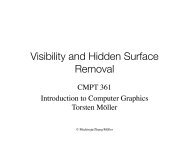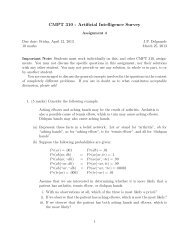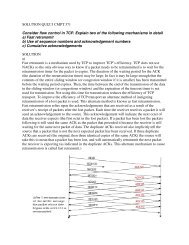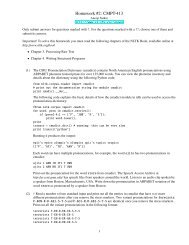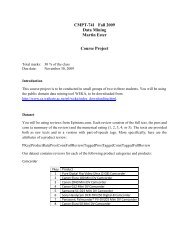cont'd
cont'd
cont'd
Create successful ePaper yourself
Turn your PDF publications into a flip-book with our unique Google optimized e-Paper software.
Chapter 6<br />
The database Language SQL<br />
Spring 2011<br />
Instructor: Hassan Khosravi
� SQL is a very-high-level language, in which the programmer is able to<br />
avoid specifying a lot of data-manipulation details that would be<br />
necessary in languages like C++.<br />
� What makes SQL viable is that its queries are “optimized” quite well,<br />
yielding efficient query executions.<br />
� The principal form of a query is:<br />
� SELECT desired attributes<br />
� FROM one or more tables<br />
� WHERE condition about tuples of the tables<br />
� SQL introduction<br />
6.2
Simple Queries in SQL<br />
Our SQL queries will be based onthe following database schema.<br />
� Movie(title, year, length, inColor, studioName, producerC)<br />
� StarsIn(movieTitle, movieYear, starName)<br />
� MovieStar(name, address, gender, birthdate)<br />
� MovieExec(name, address, cert#, netWorth)<br />
� Studio(name, address, cert#, netWorth)<br />
6.3
Simple Queries in SQL<br />
� Query all movies produced by Disney Studios in 1990<br />
�σ studioName=‘Disney’AND year=1990(Movies))<br />
� SELECT *<br />
FROM Movies<br />
WHERE studioName = ‘Disney’<br />
AND year = 1990;<br />
title year length inColor studioName procucerC#<br />
Pretty<br />
Women<br />
…<br />
1990 119 true Disney 999<br />
6.4
Projection in SQL<br />
Find the title and length of all movies produced by Disney Studios<br />
in 1990.<br />
π title,length (σ studioName=‘Disney’AND year=1990(Movies))<br />
σ studioName=‘Disney’AND year=1990π title, length ((Movies)) ?<br />
� SELECT title, length<br />
FROM Movies<br />
WHERE studioName = ‘Disney’<br />
AND year = 1990;<br />
title length<br />
Pretty Women<br />
…<br />
6.5<br />
119
Projection in SQL<br />
we can modify the name of attributes. We can change title to name and<br />
length to duration in the previous example.<br />
� SELECT title AS name, length AS duration<br />
FROM Movies<br />
WHERE studioName = ‘Disney’<br />
AND year = 1990;<br />
� We can compute the length in hours<br />
� SELECT title AS name,<br />
length/60 AS Length_In_Hours<br />
FROM Movies<br />
WHERE studioName = ‘Disney’<br />
AND year = 1990;<br />
6.6
Projection in SQL<br />
� SELECT title,<br />
length/60 AS Length<br />
‘hrs.’ AS inHours<br />
FROM Movies<br />
WHERE studioName = ‘Disney’<br />
AND year = 1990;<br />
title length inHours<br />
Pretty Women<br />
…<br />
1.98334 hrs.<br />
6.7
Selection in SQL<br />
� We may build the WHERE part using six common comparison<br />
operators (=, , , =)<br />
� Movies made by MGM studios that either were made after 1970 or<br />
were less than 90 minutes long.<br />
� SELECT title,<br />
FROM Movies<br />
WHERE ( year > 1970 or length
Pattern Matching in SQL<br />
� Retrieves the titles that starts with ‘Star’, then one blank and the 4 last<br />
chars can be anything.<br />
� SELECT title<br />
FROM Movies<br />
WHERE title LIKE ‘Star _ _ _ _’;<br />
� So, possible matches can be:<br />
‘Star War’, ‘Star Trek’<br />
6.9
Dates and Times<br />
� A date constant is represented by the keyword DATE followed by a<br />
quoted string.<br />
� For example: DATE ‘1961-08-24’<br />
� Note the strict format of the ‘YYYY-mm-dd’<br />
6.10
Ordering the Output<br />
� To get output in sorted order, we add to the select-from-where statement a<br />
clause:<br />
ORDER BY <br />
� The order is by default ascending (ASC), but we can get the output highestfirst<br />
by appending the keyword DESC.<br />
� To get the movies listed by length, shortest first, and among movies of equal<br />
length, alphabetically, we can say:<br />
SELECT *<br />
FROM Movie<br />
WHERE studioName = ‘Disney’ AND year = 1990<br />
ORDER BY length, title;<br />
6.11
QUERIES INVOLVING MORE<br />
THAN ONE RELATION<br />
Products and Joins in SQL<br />
Disambiguating Attributes<br />
Tuple Variables<br />
6.12
Products and Joins in SQL<br />
� Suppose we want to know the name of the producer of star wars.<br />
title=‘StarWars’ANDproducerC#=cert#(Movies MovieExec)<br />
SELECT *<br />
FROM Movies, MovieExec<br />
WHERE title = ‘Star Wars’<br />
AND producerC# = cert#;<br />
6.13
� Basics on Selects examples<br />
Basic Selects<br />
6.14
Disambiguating Attributes<br />
� Sometimes we ask a query involving several relations, with two or<br />
more attributes with the same name.<br />
� R.A refers to attribute A of relation R.<br />
� MovieStar(name, address, gender, birthdate)<br />
� MovieExec(name, address, cert#, netWorth)<br />
SELECT MovieStar.name, MovieExec.name<br />
FROM MovieStar, MovieExec<br />
WHERE MovieStar.address =<br />
MovieExec.address;<br />
6.15
Tuple Variables<br />
Two stars that share an address<br />
SELECT Star1.name, Star2.name<br />
FROM MovieStar Star1, MovieStar Star2<br />
WHERE Star1.address = Star2.address<br />
AND Star1.name < Star2.name;<br />
What happens if the second condition is omitted?<br />
6.16
Union, Intersection, and Difference of<br />
Queries<br />
� Its possible to use Union, Intersection, and except in SQL queries.<br />
� Query the names and addresses of all female movie stars who are<br />
also movie executives with a net worth over $10,000,000<br />
� MovieStar(name, address, gender, birthdate)<br />
� MovieExec(name, address, cert#, netWorth)<br />
(SELECT name, address FROM MovieStar<br />
WHERE gender = ‘F’)<br />
INTERSECT<br />
(SELECT name, address FROM MovieExec<br />
WHERE netWorth > 10000000)<br />
6.17
Union, Intersection, and Difference of<br />
Queries<br />
Query the names and addresses of movie stars who are not movie<br />
executives.<br />
� MovieStar(name, address, gender, birthdate)<br />
� MovieExec(name, address, cert#, netWorth)<br />
(SELECT name, address FROM MovieStar)<br />
except<br />
(SELECT name, address FROM MovieExec)<br />
6.18
Union, Intersection, and Difference of<br />
Queries<br />
� The two tables most be compatible<br />
� Query all the titles and years of movies that appeared in either the<br />
Movies or StarsIn relations.<br />
� Movie(title, year, length, inColor, studioName, producerC)<br />
� StarsIn(movieTitle, movieYear, starName)<br />
(SELECT title, year FROM Movies)<br />
UNION<br />
(SELECT movieTitle AS title, movieYear AS year<br />
FROM StarsIn)<br />
6.19
Basic Variables and set operators<br />
� Table variables and set operators examples<br />
6.20
Null Values and Comparisons Involving<br />
NULL<br />
Different interpretations for NULL values:<br />
1. Value unknown<br />
I know there is some value here but I don’t know what it is?<br />
1. Unknown birth date<br />
2. Value inapplicable<br />
There is no value that make sense here.<br />
1. Spouse of a single movie star<br />
3. Value withheld<br />
We are not entitled to know this value.<br />
1. Telephone number of stars which is known but may be shown as<br />
null<br />
6.21
Null Values and Comparisons Involving<br />
NULL<br />
� Two rules<br />
� Null plus arithmetic operators is null<br />
� When comparing the value of a null if we use = or like the value is<br />
unknown.<br />
� We use: x IS NULL or x IS NOT NULL<br />
� How unknown operates in logical expressions<br />
� If true is considered 1 and false is considred 0, then unknown is<br />
considered 0.5.<br />
� And is like min: true and unknown is unknown, false and unknown<br />
is false.<br />
� OR is like max: true and unknown is true, false and unknown is<br />
unknown.<br />
� Negation is 1 –x: negation of unknown is unknown.<br />
6.22
� Null Values examples<br />
Null Values<br />
6.23
SUBQUERIES<br />
Subqueries that Produce Scalar Values<br />
Conditions Involving Relations<br />
Conditions Involving Tuples<br />
Correlated Subqueries<br />
Subqueries in From Clauses<br />
SQL Join Expressions<br />
Natural Joins<br />
Outer Joins<br />
6.24
Subqueries that Produce Scalar Values<br />
Query the producer of Star Wars.<br />
� Movie(title, year, length, inColor, studioName, producerC)<br />
� MovieExec(name, address, cert#, netWorth)<br />
SELECT name<br />
FROM MovieExec, Movies<br />
WHERE title = “Star Wars” AND producerC# = cert#<br />
We just need the movie relation only to get the certificate number.<br />
Once we have that we could query the MovieExec for the name.<br />
6.25
Subqueries that Produce Scalar Values<br />
� use a subquery to get the producerC#<br />
SELECT name<br />
FROM MovieExec<br />
WHERE cert# = (SELECT producerC#<br />
FROM Movies<br />
WHERE title = ‘Star Wars’<br />
);<br />
� What would happen if the subquery retrieve zero or more than one<br />
tuple?<br />
� Runtime error<br />
SELECT name<br />
FROM MovieExec<br />
WHERE cert# = 12345<br />
6.26
6.3.2 Conditions Involving Relations<br />
� There are a number of SQL operators that can be applied to a relation<br />
R and produces a Boolean result.<br />
� EXISTS R is true iff R is not empty.<br />
� s IN R is true iff s is equal to one of the values in R.<br />
� s > ALL R is true iff s is greater than every value in unary relation R.<br />
Other comparison operators ( ANY R is true iff s is greater than at least one value in unary relation<br />
R. Other comparison operators (
6.3.2 Conditions Involving Relations<br />
� To negate EXISTS, ALL, and ANY operators, put NOT in front of the<br />
entire expression.<br />
� NOT EXISTS R, NOT s > ALL R, NOT s > ANY R<br />
� s NOT IN R is the negation of IN operator.<br />
� Some situations of these operators are equal to other operators.<br />
� For example:<br />
s ALL R is equal to s NOT IN R<br />
s = ANY R is equal to s IN R<br />
6.28
6.3.3 Conditions Involving Tuples<br />
� A tuple in SQL is represented by a parenthesized list of scalar values.<br />
� Examples:<br />
(123, ‘I am a string’, 0, NULL)<br />
(name, address, salary)<br />
� The first example shows all constants and the second shows attributes.<br />
� Mixing constants and attributes are allowed.<br />
6.29
� Example:<br />
6.3.3 Conditions Involving Tuples<br />
(cont’d)<br />
� ('Tom', 'Smith') IN<br />
(SELECT firstName, LastName<br />
FROM foo);<br />
� Note that the order of the attributes must be the same in the tuple and the<br />
SELECT list.<br />
6.30
Example 6.20:<br />
Conditions Involving Tuples<br />
Query all the producers of movies in which LEONARDO DICAPRIO<br />
stars.<br />
� Movie(title, year, length, inColor, studioName, producerC (movieTitle,<br />
movieYear, starName)<br />
� MovieStar(name, address, gender, birthdate)<br />
� MovieExec(name, address, cert#, netWorth)<br />
� Studio(name, address, cert#, netWorth)<br />
SELECT name, cert#<br />
); FROM MovieExec;<br />
WHERE cert# IN<br />
(SELECT producerC#<br />
FROM Movies<br />
WHERE (title, year) IN<br />
(SELECT movieTitle, movieYear<br />
FROM StarsIN<br />
WHERE starName = 'LEONARDO DICAPRIO')<br />
6.31
Conditions Involving Tuples<br />
� Note that sometimes, you can get the same result without the expensive<br />
subqueries.<br />
� For example, the previous query can be written as follows:<br />
SELECT name<br />
FROM MovieExec, Movies, StarsIN<br />
WHERE cert# = producerC#<br />
AND title = movieTitle<br />
AND year = movieYear<br />
And starName = 'LEONARDO DICAPRIO';<br />
6.32
Correlated Subqueries<br />
� The simplest subquery is evaluated once and the result is used in a<br />
higher-level query.<br />
� Some times a subquery is required to be evaluated several times, once<br />
for each assignment of a value that comes from a tuple variable outside<br />
the subquery.<br />
� A subquery of this type is called correlated subquery.<br />
6.33
Correlated Subqueries (<strong>cont'd</strong>)<br />
Query the titles that have been used for two or more movies.<br />
SELECT title<br />
FROM Movies old<br />
WHERE year < ANY<br />
(SELECT year<br />
FROM Movies<br />
� Start with the inner query<br />
WHERE title = old.title);<br />
� If old.title was a constant this would have made total sense<br />
� Where title = “king kong”<br />
� Nested loop.<br />
� For each value of old title we run the the nested subquery<br />
6.34
� Subqueries by Dr. Widom<br />
Subqueries<br />
6.35
Subqueries in From Clauses<br />
� SELECT A 1,… A n<br />
� FROM R 1, …. R m<br />
� WHERE condition � up to now we have used sub-query<br />
� SELECT A 1,… A n � use sub-query to generate an attribute<br />
� FROM R 1, …. R m � use sub-query to generate a table to<br />
condition<br />
� WHERE condition<br />
6.36
Subqueries in From Clauses<br />
� In a FROM list, we my use a parenthesized subquery.<br />
� The subquery must have a tuple variable or alias.<br />
Query the producers of LEONARDO DICAPRIO’s movies.<br />
We can write a subquery that produces a new table that can be called in<br />
the from part of the query.<br />
Select name<br />
FROM MovieExec,<br />
(SELECT producerC#<br />
FROM Movies, StarsIN<br />
WHERE title = movieTitle<br />
AND year = movieYear<br />
AND starName = 'LEONARDO DICAPRIO'<br />
) Prod<br />
WHERE cert# = Prod.producerC#;<br />
6.37
Subqueries<br />
� Subqueries in From Clauses examples<br />
6.38
SQL Join Expressions<br />
� Join operators construct new temp relations from existing relations.<br />
� These relations can be used in any part of the query that you can put a<br />
subquery.<br />
� Cross join is the simplest form of a join.<br />
� Actually, this is synonym for Cartesian product.<br />
� For example:<br />
From Movies CROSS JOIN StarsIn<br />
is equal to:<br />
From Movies, StarsIn<br />
6.39
SQL Join Expressions<br />
� If the relations we used are:<br />
� Movies(title, year, length, genre, studioName, producerC#)<br />
� StarsIn(movieTitle, movieYear, starName)<br />
� Then the result of the CROSS JOIN would be a relation with the<br />
following attributes:<br />
� R(title, year, length, genre, studioName, producerC#, movieTitle,<br />
movieYear, starName)<br />
� Note that if there is a common name in the two relations, then the<br />
attributes names would be qualified with the relation name.<br />
6.40
SQL Join Expressions<br />
� Cross join by itself is rarely a useful operation.<br />
� Usually, a theta-join is used as follows:<br />
FROM R JOIN S ON condition<br />
� For example:<br />
Movies JOIN StarsIn ON<br />
title = movieTitle AND<br />
year = movieYear<br />
� The result would be the same number of attributes but the tuples would<br />
be those that agree on both the title and year.<br />
6.41
SQL Join Expressions<br />
� Note that in the previous example, the title and year are repeated twice.<br />
Once as title and year and once as movieTitle and movieYear.<br />
� Considering the point that the resulting tuples have the same value for<br />
title and movieTitle, and year and movieYear, then we encounter the<br />
redundancy of information.<br />
� One way to remove the unnecessary attributes is projection. You can<br />
mention the attributes names in the SELECT list.<br />
6.42
Natural Joins<br />
� Natural join and theta-join differs in:<br />
1. The join condition<br />
All pairs of attributes from the two relations having a common<br />
name are equated, and also there are no other conditions.<br />
2. The attributes list<br />
One of each pair of equated attributes is projected out.<br />
� Example<br />
MovieStar NATURAL JOIN MovieExec<br />
6.43
Natural Joins<br />
Query those stars who are executive as well.<br />
The relations are:<br />
MovieStar(name, address, gender, birthdate)<br />
MovieExec(name, address, cert#, netWorth)<br />
SELECT MovieStar.name<br />
FROM MovieStar NATURAL JOIN MovieExec<br />
6.44
Outer Joins<br />
� Outer join is a way to augment the result of a join by dangling tuples,<br />
padded with null values.<br />
Example 6.25<br />
Consider the following relations:<br />
MovieStar(name, address, gender, birthdate)<br />
MovieExec(name, address, cert#, netWorth) Then<br />
MovieStar NATURAL FULL OUTER JOIN MovieExec<br />
Will produce a relation whose tuples are of 3 kinds:<br />
1. Those who are both movie stars and executive<br />
2. Those who are movie star but not executive<br />
3. Those who are executive but not movie star<br />
6.45
Outer Joins (<strong>cont'd</strong>)<br />
� We can replace keyword FULL with LEFT or RIGHT to get two new<br />
join.<br />
� NATURAL LEFT OUTER JOIN would yield the first two tuples but not<br />
the third.<br />
� NATURAL RIGHT OUTER JOIN would yield the first and third tuples<br />
but not the second.<br />
� We can have theta-outer-join as follows:<br />
� R FULL OUTER JOIN S ON condition<br />
� R LEFT OUTER JOIN S ON condition<br />
� R RIGHT OUTER JOIN S ON condition<br />
6.46
FULL-RELATION OPERATIONS<br />
Eliminating Duplicates<br />
Duplicates in Unions, Intersections, and Differences<br />
Grouping and Aggregation in SQL<br />
Aggregation Operators<br />
Grouping<br />
Grouping, Aggregation, and Nulls<br />
Having Clauses<br />
Exercises for Section 6.4<br />
6.47<br />
47
Eliminating Duplicates<br />
Query all the producers of movies in which LEONARDO DICAPRIO stars.<br />
SELECT DISTINCT name<br />
FROM MovieExec, Movies, StarsIN<br />
WHERE cer# = producerC#<br />
AND title = movieTitle<br />
AND year = movieYear<br />
And starName = LEONARDO DICAPRIO';<br />
6.48
Duplicates in Unions, Intersections,<br />
and Differences<br />
� Duplicate tuples are eliminated in UNION, INTERSECT, and EXCEPT.<br />
� In other words, bags are converted to sets.<br />
� If you don't want this conversion, use keyword ALL after the operators.<br />
(SELECT title, year FROM Movies)<br />
UNION ALL<br />
(SELECT movieTitle AS title, movieYear AS year FROM<br />
StarsIn);<br />
6.49
Grouping and Aggregation in SQL<br />
� We can partition the tuples of a relation into "groups" based on the<br />
values of one or more attributes. The relation can be an output of a<br />
SELECT statement.<br />
� Then, we can aggregate the other attributes using aggregation<br />
operators.<br />
� For example, we can sum up the salary of the employees of each<br />
department by grouping the company into departments.<br />
6.50
Aggregation Operators<br />
� SQL uses the five aggregation operators:<br />
SUM, AVG, MIN, MAX, and COUNT<br />
� These operators can be applied to scalar expressions, typically, a<br />
column name.<br />
� One exception is COUNT(*) which counts all the tuples of a query<br />
output.<br />
� We can eliminate the duplicate values before applying aggregation<br />
operators by using DISTINCT keyword. For example:<br />
COUNT(DISTINCT x)<br />
Find the average net worth of all movie executives.<br />
SELECT AVG(netWorth)<br />
FROM MovieExec;<br />
6.51
Aggregation Operators<br />
Count the number of tuples in the StarsIn relation.<br />
SELECT COUNT(*)<br />
FROM StarsIn;<br />
SELECT COUNT(starName)<br />
FROM StarsIn;<br />
These two statements do the same but you will see the difference in later<br />
slides.<br />
6.52
Grouping<br />
� We can group the tuples by using GROUP BY clause following the<br />
WHERE clause.<br />
� The keywords GROUP BY are followed by a list of grouping attributes.<br />
Find sum of the movies length each studio is produced.<br />
SELECT studioName,<br />
FROM Movies<br />
SUM(length) AS Total_Length<br />
GROUP BY studioName;<br />
6.53
Grouping<br />
� In a SELECT clause that has aggregation, only those attributes that are<br />
mentioned in the GROUP BY clause may appear unaggregated.<br />
� For example, in previous example, if you want to add genre in the<br />
SELECT list, then, you must mention it in the GROUP BY list as well.<br />
SELECT studioName, genre,<br />
FROM Movies<br />
SUM(length) AS Total_Length<br />
GROUP BY studioName, genre;<br />
6.54
Grouping<br />
� It is possible to use GROUP BY in a more complex queries about<br />
several relations.<br />
� In these cases the following steps are applied:<br />
1. Produce the output relation based on the<br />
select-from-where parts.<br />
2. Group the tuples according to the list of attributes mentioned in the<br />
GROUP BY list.<br />
3. Apply the aggregation operators<br />
Create a list of each producer name and the total length of film produced.<br />
SELECT name, SUM(length)<br />
FROM MovieExec, Movies<br />
WHERE producerC# = cert#<br />
GROUP BY name;<br />
6.55
Grouping, Aggregation, and Nulls<br />
� What would happen to aggregation operators if the attributes have null<br />
values?<br />
� There are a few rules to remember<br />
1. NULL values are ignored when the aggregation operator is<br />
applied on an attribute.<br />
2. COUNT(*) counts all tuples of a relation, therefore, it counts the<br />
tuples even if the tuple contains NULL value.<br />
3. NULL is treated as an ordinary value when forming groups.<br />
4. When we perform an aggregation, except COUNT, over an empty<br />
bag, the result is NULL. The COUNT of an empty bag is 0<br />
6.56
Grouping, Aggregation, and Nulls<br />
Consider a relation R(A, B) with one tuple, both of whose components are<br />
NULL. What's the result of the following SELECT?<br />
SELECT A, COUNT(B)<br />
FROM R<br />
GROUP BY A;<br />
The result is (NULL, 0) but why?<br />
What's the result of the following SELECT?<br />
SELECT A, COUNT(*)<br />
FROM R<br />
GROUP BY A;<br />
The result is (NULL, 1) because COUNT(*) counts the number of tuples<br />
and this relation has one tuple.<br />
6.57
Grouping, Aggregation, and Nulls<br />
What's the result of the following SELECT?<br />
SELECT A, SUM(B)<br />
FROM R<br />
GROUP BY A;<br />
The result is (NULL, NULL) because SUM(B) address one NULL value<br />
which is NULL.<br />
6.58
HAVING Clauses<br />
� So far, we have learned how to restrict tuples from contributing in the<br />
output of a query.<br />
� How about if we don't want to list all groups?<br />
� HAVING clause is used to restrict groups.<br />
� HAVING clause followed by one or more conditions about the group.<br />
Query the total film length for only those producers who made at least one<br />
film prior to 1930.<br />
SELECT name, SUM(length)<br />
FROM MovieExec, Movies<br />
WHERE producerC# = cert#<br />
GROUP BY name<br />
HAVING MIN(year) < 1930;<br />
6.59
HAVING Clauses<br />
� The rules we should remember about HAVING:<br />
1. An aggregation in a HAVING clause applies only to the tuples of<br />
the group being tested.<br />
2. Any attribute of relations in the FROM clause may be aggregated<br />
in the HAVING clause, but only those attributes that are in the<br />
GROUP BY list may appear unaggregated in the HAVING clause<br />
(the same rule as for the SELECT clause).<br />
6.60
HAVING Clauses<br />
� The order of clauses in SQL queries would be:<br />
� SELECT<br />
� FROM<br />
� WHERE<br />
� GROUP BY<br />
� HAVING<br />
� Only SELECT and FROM are mandatory.<br />
� There is one important difference between SQL HAVING and SQL<br />
WHERE clauses. The SQL WHERE clause condition is tested against<br />
each and every row of data, while the SQL HAVING clause condition is<br />
tested against the groups and/or aggregates specified in the SQL<br />
GROUP BY clause and/or the SQL SELECT column list.<br />
6.61
DATABASE MODIFICATIONS<br />
Insertion<br />
Deletion<br />
Updates<br />
6.62
Insertion<br />
� The syntax of INSERT statement:<br />
INSERT INTO R(A 1, ..., A N)<br />
VALUES (v 1, ..., v n);<br />
� If the list of attributes doesn't include all attributes, then it put default<br />
values for the missing attributes.<br />
6.63
Insertion<br />
If we are sure about the order of the attributes, then we can write<br />
the statement as follows:<br />
INSERT INTO StarsIn<br />
VALUES ('The Maltese Falcon', 1942, 'Sydney<br />
Greenstreet');<br />
If not<br />
INSERT INTO StarsIn(MovieTitle, movieYear,<br />
starName)<br />
VALUES ('The Maltese Falcon', 1942, 'Sydney<br />
Greenstreet');<br />
6.64
Insertion<br />
� The simple insert can insert only one tuple, however, if you want to<br />
insert multiple tuples , then you can use the following syntax:<br />
INSERT INTO R(A 1, ..., A N)<br />
SELECT v 1, ..., v n<br />
FROM R 1, R 2, ..., R N<br />
WHERE ;<br />
� Suppose that we want to insert all studio names that are mentioned in<br />
the Movies relation but they are not in the Studio yet.<br />
INSERT INTO Studio(name)<br />
SELECT studioName<br />
FROM Movies<br />
WHERE studionName NOT IN<br />
(SELECT name<br />
FROM Studio);<br />
6.65
� The syntax of DELETE statement:<br />
DELETE FROM R<br />
WHERE ;<br />
Deletion<br />
� Every tuples satisfying the condition will be deleted from the relation R.<br />
DELETE FROM StarsIn<br />
WHERE movieTitle = 'The Maltese Falcon' AND<br />
movieYear = 1942 AND<br />
starName = 'Sydney Greenstreet';<br />
Delete all movie executives whose net worth is less than ten million<br />
dollars.<br />
DELETE FROM MovieExec<br />
WHERE netWorth < 10000000;<br />
6.66
Updates<br />
� The syntax of UPDATE statement:<br />
UPDATE R<br />
SET <br />
WHERE ;<br />
� Every tuples satisfying the condition will be updated from the relation R.<br />
� If there are more than one value-assignment, we should separate them<br />
with comma.<br />
Attach the title 'Pres.' in front of the name of every movie executive who is<br />
the president of a studio.<br />
UPDATE MovieExec<br />
SET name = 'Pres.' || name<br />
WHERE cert# IN (SELECT presC# FROM Studio);<br />
6.67
TRANSACTIONS IN SQL<br />
Serializability<br />
Atomicity<br />
Transactions<br />
Read-Only Transactions<br />
Dirty Reads<br />
Other Isolation Levels<br />
Exercises for Section 6.6<br />
6.68
6.6 Transactions in SQL<br />
� Up to this point, we assumed that:<br />
� the SQL operations are done by one user.<br />
� The operations are done one at a time.<br />
� There is no hardware/software failure in middle of a database<br />
modification. Therefore, the operations are done atomically.<br />
� In Real life, situations are totally different.<br />
� There are millions of users using the same database and it is possible<br />
to have some concurrent operations on one tuple.<br />
6.69
6.6.1 Serializability<br />
� In applications like web services, banking, or airline reservations,<br />
hundreds to thousands operations per second are done on one<br />
database.<br />
� It's quite possible to have two or more operations affecting the same,<br />
let's say, bank account.<br />
� If these operations overlap in time, then they may act in a strange way.<br />
� Let's take an example.<br />
6.70
Example 6.40<br />
6.6.1 Serializability (<strong>cont'd</strong>)<br />
Consider an airline reservation web application. Users can book their<br />
desired seat by themselves.<br />
The application is using the following schema:<br />
Flights(fltNo, fltDate, seatNo, seatStatus)<br />
When a user requests the available seats for the flight no 123 on date<br />
2011-12-15, the following query is issued:<br />
6.71<br />
71
SELECT seatNo<br />
FROM Flights<br />
6.6.1 Serializability (<strong>cont'd</strong>)<br />
WHERE fltNo = 123 AND<br />
fltDate = DATE '2011-12-25' AND<br />
seatStatus = 'available';<br />
When the customer clicks on the seat# 22A, the seat status is changed by<br />
the following SQL:<br />
UPDATE Flights<br />
SET seatStatus = 'occupied'<br />
WHERE fltNo = 123 AND<br />
fltDate = DATE '2011-12-25' AND<br />
seatNo = '22A';<br />
6.72
6.6.1 Serializability (<strong>cont'd</strong>)<br />
� What would happen if two users at the same time click on the reserve<br />
button for the same seat#?<br />
� Both see the same seats available and both reserve the same seat.<br />
� To prevent these happen, SQL has some solutions.<br />
� We group a set of operations that need to be performed together. This<br />
is called 'transaction'.<br />
6.73
6.6.1 Serializability (<strong>cont'd</strong>)<br />
� For example, the query and the update in example 6.40 can be<br />
grouped in a transaction.<br />
� SQL allows the programmer to state that a certain transaction must be<br />
serializable with respect to other transactions.<br />
� That is, these transactions must behave as if they were run serially,<br />
one at a time with no overlap.<br />
6.74
6.6.2 Atomicity<br />
� What would happen if a transaction consisting of two operations is in<br />
progress and after the first operation is done, the database and/or<br />
network crashes?<br />
� Let's take an example.<br />
6.75
Example 6.41<br />
6.6.2 Atomicity (<strong>cont'd</strong>)<br />
Consider a bank's account records system with the following relation:<br />
Accounts(acctNo, balance)<br />
Let's suppose that $100 is going to transfer from acctNo 123 to acctNo<br />
456.<br />
To do this, the following two steps should be done:<br />
1. Add $100 to account# 456<br />
2. Subtract $100 from account# 123.<br />
6.76
6.6.2 Atomicity (<strong>cont'd</strong>)<br />
The needed SQL statements are as follows:<br />
UPDATE Accounts<br />
SET balance = balance + 100<br />
WHERE acctNo = 456;<br />
UPDATE Accounts<br />
SET balance = balance - 100<br />
WHERE acctNo = 123;<br />
What would happen if right after the first operation, the database crashes?<br />
6.77
6.6.2 Atomicity (<strong>cont'd</strong>)<br />
� The problem addressed by example 6.41 is that certain combinations of<br />
operations need to be done atomically.<br />
� That is, either they are both done or neither is done.<br />
6.78
6.6.3 Transactions<br />
� The solution to the problems of serialization and atomicity is to group<br />
database operations into transactions.<br />
� A transaction is a set of one or more operations on the database that<br />
must be executed atomically and in a serializable manner.<br />
� To create a transation, we use the following SQL command:<br />
START TRANSACTION<br />
6.79
6.6.3 Transactions (<strong>cont'd</strong>)<br />
� There are two ways to end a transaction:<br />
1. The SQL receives COMMIT command.<br />
2. The SQL receives ROLLBACK command.<br />
� COMMIT command causes all changes become permanent in the<br />
database.<br />
� ROLLBACK command causes all changes undone.<br />
6.80
6.6.4 Read-Only Transactions<br />
� We saw that when a transaction read a data and then want to write<br />
something, is prone to serialization problems.<br />
� When a transaction only reads data and does not write data, we have<br />
more freedom to let the transaction execute in parallel with other<br />
transactions.<br />
� We call these transactions read-only.<br />
6.81
6.6.4 Read-Only Transactions (<strong>cont'd</strong>)<br />
Example 6.43<br />
Suppose we want to read data from the Flights relation of example 6.40 to<br />
determine whether a certain seat was available?<br />
What's the worst thing that can happen?<br />
When we query the availability of a certain seat, that seat was being<br />
booked or was being released by the execution of some other program.<br />
Then we get the wrong answer.<br />
6.82
6.6.4 Read-Only Transactions (<strong>cont'd</strong>)<br />
� If we tell the SQL that our current transaction is read-only, then SQL<br />
allows our transaction be executed with other read-only transactions in<br />
parallel.<br />
� The syntax of SQL command for read-only setting:<br />
SET TRANSACTION READ ONLY;<br />
� We put this statement before our read-only transaction.<br />
6.83
6.6.4 Read-Only Transactions (<strong>cont'd</strong>)<br />
� The syntax of SQL command for read-write setting:<br />
SET TRANSACTION READ WRITE;<br />
� We put this statement before our read-write transaction.<br />
� This option is the default.<br />
6.84<br />
84
6.6.5 Dirty Reads<br />
� The data that is written but not committed yet is called dirty data.<br />
� A dirty read is a read of dirty data written by another transaction.<br />
� The risk in reading dirty data is that the transaction that wrote it never<br />
commit it.<br />
� Sometimes dirty read doesn’t matter much and is not worth<br />
� The time consuming work by the DBMS that is needed to prevent<br />
data reads<br />
� The loss of parallelism that results from waiting until there is no<br />
possibility of a dirty read<br />
6.85
Example 6.44<br />
6.6.5 Dirty Reads (<strong>cont'd</strong>)<br />
Consider the account transfer of example 6.41.<br />
Here are the steps:<br />
1. Add money to account 2.<br />
2. Test if account 1 has enough money?<br />
a. If there is not enough money, remove the money from<br />
account 2 and end.<br />
b. If there is, subtract the money from account 1 and end.<br />
Imagine, there are 3 accounts A1, A2, and A3 with $100, $200, and $300.<br />
6.86<br />
86
Let's suppose:<br />
6.6.5 Dirty Reads (<strong>cont'd</strong>)<br />
Transaction T1 transfers $150 from A1 to A2<br />
Transaction T2 transfers $250 from A2 to A3<br />
What would happen if the dirty read is allowed?<br />
� T2 executes step (1) adds 250 to A3 which now has 550<br />
� T1 executes step (1) adds 150 to A2 which now has 350<br />
� T2 executes step (2), A2 has enough fund<br />
� T1 executes step (2) A1 doesn’t have enough fund<br />
� T2 executes step (2b) and leaves A2 with $100<br />
� T1 executes step (2a) and leaves A1 with $-50<br />
� How important is it in the reservation scenario?<br />
6.87<br />
87
6.6.5 Dirty Reads (<strong>cont'd</strong>)<br />
� The syntax of SQL command for dirty-read setting:<br />
SET TRANSACTION READ WRITE<br />
ISOLATION LEVEL READ UNCOMMITTED;<br />
� We put this statement before our read-write transaction.<br />
� This option is the default.<br />
6.88<br />
88
6.6.6 Other Isolation Levels<br />
� There are four isolation level.<br />
� We have seen the first two before.<br />
� Serializable (default)<br />
� Read-uncommitted<br />
� Read-committed<br />
Syntax:<br />
SET TRANSACTION<br />
ISOLATION LEVEL READ COMMITTED;<br />
6.89<br />
89
6.6.6 Other Isolation Levels (<strong>cont'd</strong>)<br />
� For each the default is 'READ WRITE' (except the isolation READ<br />
UNCOMMITTED that the default is 'READ ONLY') and if you want<br />
'READ ONLY', you should mention it explicitly.<br />
� The default isolation level is 'SERIALIZABLE'.<br />
� Note that if a transaction T is acting in 'SERIALIZABLE' level and the<br />
other one is acting in 'READ UNCOMMITTED' level, then this<br />
transaction can see the dirty data of T. It means that each one acts<br />
based on their level.<br />
6.90<br />
90
6.6.6 Other Isolation Levels (<strong>cont'd</strong>)<br />
� Under READ COMMITTED isolation, it forbids reading the dirty data.<br />
� But it does not guarantee that if we issue several queries, we get the<br />
same tuples.<br />
� That's because there may be some new committed tuples by other<br />
transactions.<br />
� The query may show more tuples because of the phantom tuples.<br />
� A phantom tuple is a tuple that is inserted by other transactions.<br />
6.91<br />
91
6.6.6 Other Isolation Levels (<strong>cont'd</strong>)<br />
Example 6.46<br />
Let's consider the seat choosing problem under 'READ COMMITTED'<br />
isolation.<br />
Your query won't see seat as available if another transaction reserved it<br />
but not committed yet.<br />
You may see different set of seats in subsequent queries depends on if<br />
the other transactions commit their reservations or rollback them.<br />
6.92<br />
92
6.6.6 Other Isolation Levels (<strong>cont'd</strong>)<br />
� Properties of SQL isolation levels<br />
Isolation<br />
Level<br />
Dirty Read Phantom<br />
Read<br />
Uncommitted � �<br />
Read<br />
Committed - �<br />
Serializable - -<br />
6.95<br />
95



